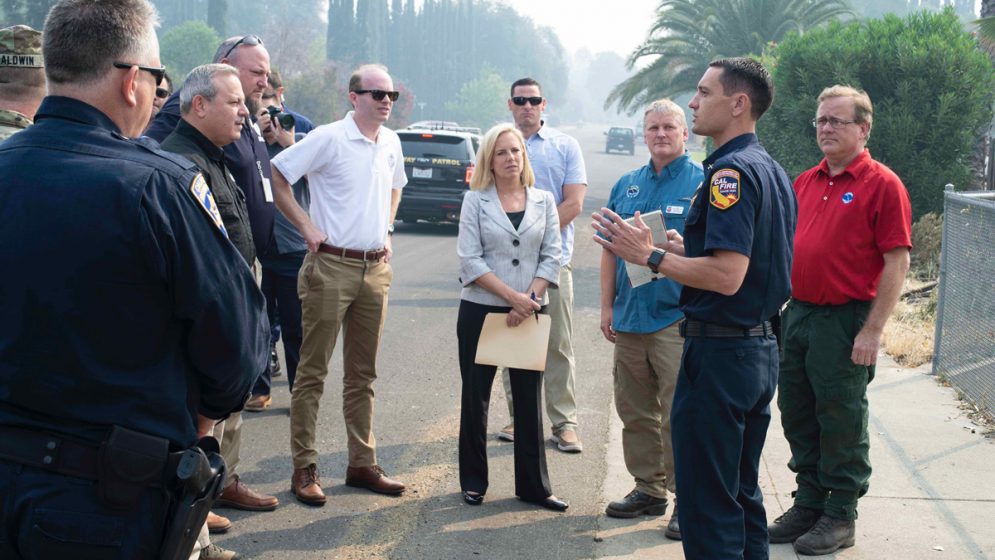2018: Remnant moisture from Tropical Storm Rosa advanced into Southern California, bringing rain and widespread thunderstorms to the region, particularly the mountains and deserts.
In the Coachella Valley, a strong thunderstorm accumulated up to 3.5" of rain in 2 hours near Mecca.
One fatality resulted from the storm near Mecca.
An individual was swept away on Box Canyon road.
2010: Fresno set a record high of 101° F beating the old record of 99° F set back in 1991.
This old record was the only record high maximum temperature that was below 100° F degrees for
September.
All of the record high maximum temperatures for Fresno for the month of
September are now in the triple digits.
2001: Tropical Depression Juliette ignited thunderstorms in the inland valleys, mountains and deserts on this day and on 10/1.
Flooding was reported in Beaumont.
One was killed by lightning at Cuyamaca Rancho State Park.
In the Coachella Valley, strong downburst winds downed trees and produced a dust storm that reduced visibility to near zero.
1988: Fresno set a high of 99° F, making it the only day during the month of September the city has never seen a triple digit high temperature.
1983: Low pressure off the coast ignited thunderstorms over the L.A. Basin. The storms produced two tornadoes, one in Walnut Park and a second in Hawthorne.
The Hawthorne tornado was on the ground for 1.4 miles, during which time it unroofed 8 homes and damaged 60 others.
Winds were estimated at 100 mph (ranking F2on the Fujita scale).
1982: It was 49° F in Borrego Springs, the lowest temperature on record for
September.
This also occurred on 9.27.1986 and 9.
30.1971.
1971: Caribbean Sea Hurricane Irene crossed Nicaragua and reformed in the eastern Pacific as Hurricane Olivia.
Olivia recurved to the northeast and made landfall in central Baja
California with rainfall of up to 1" in the southern deserts on this day and on 10.1.
This occurred during the La Niña of 1970-71.
1971: 4" of snow fell at Donner Memorial State Park near Truckee.
1970: Drought in Southern California climaxed and hot Santa Ana winds blew starting on 9/25 and ending on this day.
Winds peaked at 60 mph at Cuyamaca.
The winds downed powerlines, which sparked the Laguna Fire, one of the largest wildfires in California history.
8 people were killed, 382 homes were destroyed, and 175,425 acres were burned.
The fire consumed whole communities of interior San Diego County.
500,000 acres were burned and caused fifty million dollars in damage.
1950: Livermore had a low temperature of 35° F. 1950: Fresno reached a chilly 37° F for a low temperature, establishing a record low for the month.
This is also the earliest low temperature in the season below 40° F on record in Fresno.
Frost was reported in the Fresno area as well for the earliest time ever.
1950: The morning low temperature at Reno, NV was 21° F.
1946: Woodfords (Alpine Co.) recorded 1.27" of precipitation.1946: A tropical storm moved northward into northern Baja
California and dissipated with rainfall of up to 4" in the mountains on this day and exceeding 4" in the mountains on 10.1.
This occurred during the El Niño of 1946-47.
1932: Flash flood at Woodfords (Alpine Co. near Markleeville) generated a 45-foot wall of water which killed 15 people and destroyed several locomotives.
Flash flooding also occurred in the Tehachapi Mountains.
1932: Remnants from a tropical system helped to produce 1.1" of rain in Las Vegas, NV, causing several roads to become flooded and impassable.
1932: Heavy rains starting on 9.28 and ending on 10.1 came from a dying tropical cyclone.
It brought flooding to parts of the mountains and deserts of Southern
California.
4.38" of rain fell at Tehachapi in 7 hours on this day.
Floods in Tehachapi resulted in 15 deaths.
1930: It was 46° in Palm Springs, the lowest temperature on record for
September.
1921: 1.23" of rain fell in San Diego, the greatest daily amount on record for
September.
1.5" fell on this day and on 10.1, the greatest 24-hour total on record for
September.
1921: A tropical storm crossed the Baja peninsula southwest of Yuma, AZ, and moved up the Colorado River Valley.
Several stations along the Colorado River reported in excess of 3" of rain, including 3.65" at Yuma.
Other amounts included 1.50" at Flagstaff, 1.24" at Prescott, 0.68" at Tucson, and 0.56" at Phoenix, AZ.
1894: Fresno had its' coldest maximum on record for the month of
September – the high this day reached only 56° F.
Source: NWS San Francisco/Monterey, Hanford, Reno, Las Vegas, Phoenix, & San Diego
--
| |
![--]() | | Kim Noyes ![https://]() about.me/kim.noyes | |
 |
You receive all messages sent to this group.










